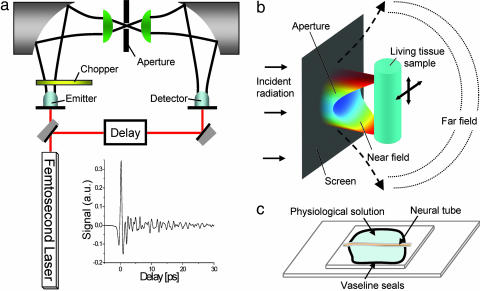Fig. 5.
Setup. (a) Terahertz generation and detection with photoconductive antenna. A femtosecond pulse generates terahertz pulses, which propagate through free space, and which is detected in amplitude by the detector antenna. A chopper and lock-in device allows one to record the amplitude of the electric field, as shown in the Inset. (b) Setup for near-field microscopy with aperture. Terahertz radiation was focused onto a sub-wavelength hole by a hyper-hemispherical Teflon lens. The living tissue sample was put behind the hole, and the transmitted terahertz pulse was focused by another hemispherical lens to the photoconductive detector. Near-field distribution shows highly anisotropic electric field spatial profile at the output of the hole, computed by 3D FEM. (c) The central neural tube of L. terrestris worm was glued on a 200-μm-thick glass microscope plate (microcover glass 24 × 50 mm; Erie Scientific, Portsmouth, NH), by Vaseline seals (100 μm), bathed in a physiological solution, and covered by a second 18 × 18-mm microcover plater. Constant sample thickness was obtained by a calibrated intercalary. The composition of the physiological solution was 110.5 mM NaCl, 2.5 mM KCl, 2 mM CaCl2, and 10 mM Hepes (NaOH) buffer (pH 7.35).

